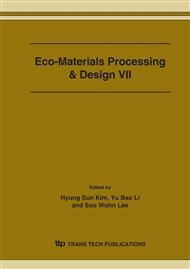p.62
p.66
p.70
p.74
p.78
p.82
p.86
p.90
p.94
Preparation and Antibacterial Activity of Silver Ions-Substituted Hydroxyapatite/Titania
Abstract:
In this paper a series of silver ions-substituted hydroxyapatites (HA) were prepared. The antibacterial activities of these materials on textiles against bacteria have been investigated. Titania (TiO2) was selectively added into the materials to decrease the silver-ions concentration to get the same active antimicrobial effects. The microstructure, the shape and size, concentration of silver, and the groups of the composite materials were characterized using transmission electron microscopy (TEM), infrared spectroscopy (IR), Atomic absorption spectroscopy (AAS), and X-ray diffraction (XRD). The results showed that there was a dose dependent-effect of silver-ions concentration from the disk diffusion test. The higher the silver-ions concentration, the better the antibacterial activity of the composite materials was. Keeping silver-ions concentration constant, the antibacterial activity of the materials for adding Titania was better than that of without Titania. Moreover, the addition of Titania would inhibit the discolouration of the composite materials. The antibacterial activities of the composite materials differentiate to some extent with the bacterial strains.
Info:
Periodical:
Pages:
78-81
Citation:
Online since:
March 2006
Authors:
Price:
Сopyright:
© 2006 Trans Tech Publications Ltd. All Rights Reserved
Share:
Citation:


